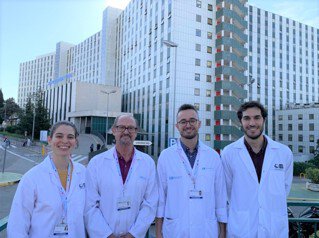Diego San José-Saras, Jorge Vicente-Guijarro, Paulo Sousa, Paloma Moreno-Núñez and Jesús María Aranaz-Andrés. Inappropriate hospital admission as a risk factor for the subsequent development of adverse events: a cross-sectional study
BMC Med. 2023
"Traditionally, it has been assumed that medical overuse implied a greater risk of AEs, which is an uncorroborated hypothesis. With this study, we have estimated a direct association measure in a pioneering way, allowing us to open new hypotheses in the fields of overuse and patient safety." - Prof. Jesús Mª Aranaz, Dr. Diego San José-Saras & Dr. Jorge de Vicente-Guijarro -
Summary:
Background: All health overuse implies an unnecessary risk of patients suffering adverse events (AEs). However, this hypothesis has not been corroborated by direct estimates for inappropriate hospital admission (IHA). The objectives of the study were the following: (1) to analyze the association between IHA and the development of subsequent AEs; (2) to explore the distinct clinical and economic implications of AEs subsequent IHA compared to appropriate admissions.
Methods: An observational cross-sectional study was conducted on hospitalized patients in May 2019 in a high-complexity hospital in Madrid, Spain. The Appropriateness Evaluation Protocol was used to measure IHA, and the methodologies of the Harvard Medical Practice Study and the European Point Prevalence Survey of Healthcare-associated Infections were used to detect and characterize AEs. The association between IHA and the subsequent.
Results: A total of 558 patients in the hospital ward were studied. IHA increased the risk of subsequent occurrence of AEs (OR [95% CI]: 3.54 [1.87 to 6.69], versus appropriate) and doubled the mean AEs per patient (coefficient [95% CI]: 0.19 [0.08 to 0.30] increase, versus appropriate) after adjusting for confounders. IHA was a predictive variable of subsequent AEs and the number of AEs per patient. AEs developed after IHA were associated with scheduled admissions (78.9% of AEs, versus 27.9% after appropriate admissions; p < 0.001). Compared with AEs developed after appropriate admissions, AEs after IHA added 2.4 additional days of stay in the intensive care unit and incurred an extra cost of €166,324.9 for the studied sample.
Conclusions: Patients with IHA have a higher risk of subsequent occurrence of AE. Due to the multifactorial nature of AEs, IHA is a possible contributing factor. AEs developed after IHA are associated with scheduled admissions, prolonged ICU stays, and resulted in significant cost overruns.
Why do you highlight this publication?
IHA is a significant healthcare problem due to its worldwide impact on patient safety and efficiency. The assumption that medical overuse implies a greater risk of AEs is a globally accepted premise. However, this hypothesis has not been corroborated, and further studies are necessary.
To date, this is the first study that directly estimates the association between the IHA and the subsequent occurrence of AEs. Therefore, this study proposes that IHA could be a potential risk factor for AEs. In addition, this measure of association was analyzed based on different study units, and models were adjusted for various clinical and epidemiological variables, such as intrinsic and extrinsic risk factors not considered in previous appropriateness works.
For that, this study is also a pioneer in combining standardized, validated, and internationally accepted methodologies, such as the Appropriateness Evaluation Protocol to assess the IHA, the Harvard Medical Practice for identifying and characterizing adverse events, and the European Point Prevalence Survey of Healthcare-associated Infections as an additional high-quality screening for identifying healthcare-associated infections.
The joint and simultaneous use of these methodologies is positioned as a new surveillance system regarding patient safety, capable of analyzing the IHA as a possible contributing factor to AEs. For all these reasons, this study constitutes a significant novelty in Patient Safety, allowing new hypotheses and research opportunities in this field.
Publication commented by:
Prof. Prof. Jesús Mª Aranaz & Dr. Diego San José-Saras
Ramón y Cajal University Hospital
HEALTH OUTCOMES RESEARCH-IRYCIS



